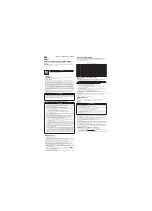
35-0699-99X01
Nuisance Odor Pad Assembly, 1/Case
35-0799-99X01
Nuisance Odor Pad, 1/case
35-0799-99X10
Nuisance Odor Pad, 10/case
15-0399-99X02
Organic Vapor/Acid Gas* Cartridge, 2/case
15-0399-99X06
Organic Vapor/Acid Gas* Cartridge, 6/case
15-0499-99X02
Organic Vapor/Acid Gas* Cartridge, 2/case
15-0499-99X06
Organic Vapor/Acid Gas* Cartridge, 6/case
15-0009-99X02
Spark Arrestor, 2/case
* Acid gas: NIOSH approved for sulfur dioxide, chlorine, hydrogen chloride
TROUBLESHOOTING
Use the table below to help identify possible causes and corrective action for problems you may experience. There are no
user serviceable parts inside the 3M™ Adflo™ PAPR Assembly. The motor/blower unit should not be opened to attempt
repairs. Consult the 3M™ Adflo™ PAPR Trouble Shooting Guide or contact 3M Technical Service to help identify additional
possible causes and corrective actions for other problems you may experience.
Fault
Probable Cause(s)
Possible Solution(s)
Low air flow alarm (audible
and all three LEDs on
power button are lit)
1. Breathing tube is blocked.
2. Filter is blocked.
3. Filter is fully loaded with
particles.
4. PAPR is being used above
recommended altitude
limitation.
1. Check & remove blockage or obstruction.
2. Check air filter & remove obstruction.
3. Change HE filter and pre-filter. If using a
chemical cartridge, check that the scrim
fabric behind the inlet holes is clean and
white. Any sign of particle loading on the
chemical cartridge indicates improper
installation or damaged particle filter
assembly.
4. Consider 3M™ High Altitude Compensation
Adflo™ PAPR or an alternative 3M™ PAPR.
Bottom bar of battery
indicator flashes; battery
alarm sounds
Low battery voltage.
1. Fully charge the battery pack.
2. Install a new, fully-charged 3M™ Adflo™
PAPR Battery Pack.
No air flow, no alarm(s)
1. Battery contact on battery
pack is damaged.
2. Battery is completely
discharged.
3. Damaged circuit board.
4. Damaged
motor.
1. Check that the battery contact is not bent or
broken.
2. Fully charge the battery pack.
3 and 4. Contact 3M Warranty and Repair.
Low air flow per indicator
but no alarm(s)
1. Damaged circuit board.
2. Damaged
motor.
Contact 3M Warranty and Repair.
User detects odor or taste
of contaminants or feels
eye or throat irritation
1. Incorrect
respirator
for application and/or
environment.
2. Chemical cartridge exhausted.
3. Nuisance odor pad.
4. Particle filter damaged.
1. Consult on-site industrial hygienist or safety
director.
2. Change cartridge & develop a cartridge
replacement schedule with your on-site
industrial hygienist or safety director.
3. Replace nuisance odor pad.
4. Replace particle filter.
Battery pack’s charge lasts
less than expected
1. Inadequate
charging.
2. HE filter is loaded with
particles, making the motor
run harder.
3. Chemical cartridge being
used.
4. Motor blower is being used at
high elevations.
1. Check the filter-loading indicator.
2. Replace the HE filter & pre-filter as indicated,
and examine the spark arrestor.
3. Battery pack will normally have shorter run
time with chemical cartridge in place.
4. Consider 3M™ High Altitude Compensation
Adflo™ PAPR or an alternative 3M™ PAPR.
The motor runs “faster than
normal”
1. The HE filter is loaded with
particles.
2. Recent user change from just
HE filter to HE and Nuisance
Odor Pad Assembly or HE and
OV/AG cartridge.
1. Check the filter-loading indicator. Replace
the HE filter & pre-filter as indicated, and
examine the spark arrestor.
2. Normal operation. Let the unit run for 2
minutes so it can automatically adjust to new
configuration.
The motor runs “slower
than normal”
1. Recent user change from
HE and Nuisance Odor Pad
Assembly or HE filter and
OV/SD/CL/HC cartridge to just
the HE filter.
1. Normal operation. Let the unit run for 2
minutes so it can automatically adjust to the
new filter configuration.
Fig. 1
Fig. 12
ON
OF
E1
Fig. 13
Fig. 2
Fig. 14
Fig. 3
Fig. 7
Fig. 8
Fig. 9
Fig. 9A
Fig. 10
Fig. 11
Fig. 5
1- Cover; 2 - Spark Arrestor; 3-Pre-filter; 4 - HE Filter
1- Protège-filtre; 2- Pare-étincelles; 3- Préfiltre;
4- Filtre à haute efficacité
Fig. 4
Fig. 6













